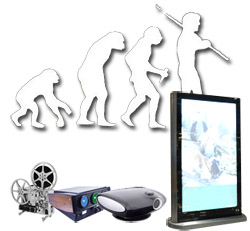Is the Projector Dying a Slow Death?
 In light of the rapid evolution of the large-format LCD monitor, LED-backlit LCD TVs and the rise of the giant-sized LCDs, it’s time to ask the question no one in the ProAV market really wants answered: Is the projector dying?
In light of the rapid evolution of the large-format LCD monitor, LED-backlit LCD TVs and the rise of the giant-sized LCDs, it’s time to ask the question no one in the ProAV market really wants answered: Is the projector dying?
Since the dawn of the video projection market in the late 1970s, it’s dominated, albeit in different iterations, the presentation landscape in boardrooms, meeting rooms and classrooms. That success also spilled over into the rental-staging, church, and even the home theater markets. In all those spaces, the LCD or DLP projector simply dominates the applications.
And, why not? Although it’s small, it can make a huge picture and now it’s amazingly cheap. At a recent dealer event I attended in New York, one new projector manufacturer showed me a 4000 ANSI lumen portable projector for $1500 that they told me would ship in 2010!
But, how long will this last? It’s been 40 years of continuous domination by basically by only three technologies (first CRT, then LCD and now it’s shared by LCD and DLP) that basically do the same thing – hang them in the ceiling, turn them on and project virtually any reasonable picture for a given room size.
Ah, but there are inherent flaws – flaws that we design around, teach sales people to sell around and even those that we not dare tell a client until they figure it out for themselves.
For example, what about the “giant cone of unusable space” (using my 22-year industry pal Joel Rollins’ words) that the projector takes up? And, he’s right. The light path that the projected image follows from projector to screen is unusable space for sure. In fact, in designing meeting rooms and classrooms, we’re forced to not allow seating in, basically, the best seats in the house!
And, noise. Ugh! This one just frustrates me to no end. The best projectors – those that make the best images in PC and HD projection – are some of the loudest on the market. In many cases, we don’t realize how loud they are until we install them in our own homes. Watch a movie with some sort of slow, romantic/quiet scene and you’ll hear more fan than dialog. I don’t dare use a projector in my classroom whenever administering a test to my students at UNC’s Journalism School as I am bound to have three or four students begging me to turn it off. To some, the white noise delivered by a projector is soothing; to others apparently it’s akin to fingernails on a chalkboard.
And, although we’ve got bright projectors (again, even noisier), nearly every room designed by a ProAV integrator has to consider lighting control and ambient lighting issues, still. No matter how bright they get, they never seem bright enough. Now that the government is going to restrict our lighting choices, we’re going to be forced to use fluorescent lighting – ugh, again!
Now, before you think I’m sort of projector hater, be realistic – even if you work for a projector manufacturer, you have to admit all these things have crossed your mind whenever you imagine the future of AV. Seriously?!?
Then, one day you walk into InfoComm and see either Panasonic’s giant 85” plasma (a technology in itself that hosts a ton of problematic issues) or Sharp’s 103” LCD monitors. Didn’t you get TV-envy? If you had a choice, wouldn’t you seriously consider a 100” LCD TV?
Truth is, the projector’s here a long time to come. It’ll be at least a decade or better before the price, weight, ease-of-install and size of LCD or any other flat screen technology is competitive to front or rear-screen projection. But, that day WILL come. And, when I see new technologically creative products like Christie Digital’s MicroTiles (a shallow-depth, mini-cube-like, stackable rear-screen DLP technology) I think, that day may be sooner than we think.
Half-inch thick LED-lit TVs, ePaper, bendable display technology and a host of new, yet-to-be-announced flat-screen technologies will slowly chip away at the projection market. We all know it. Remember the days when you had rooms where the projected image was only 40”, 50” or even 60” and you used projectors? Can you imagine doing that now? Statistically, well over 90 percent of those application have already shifted to plasma and LCD flat screen displays. And, 65” is next. When will those technologies gobble up 80”, 90” and even 100”? Heck, is a decade really that long? Remember Y2K?


